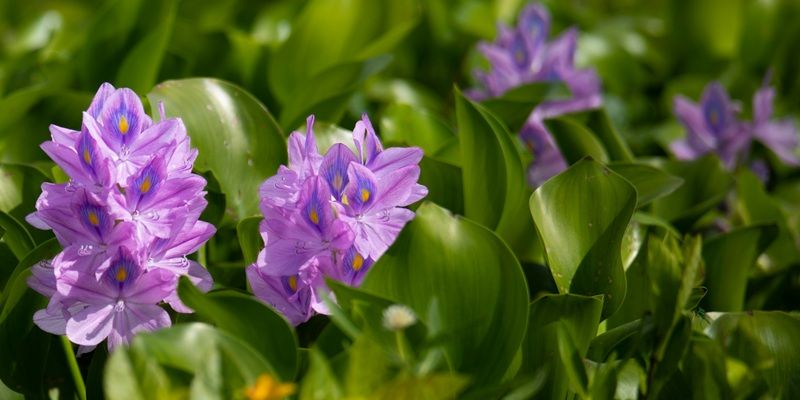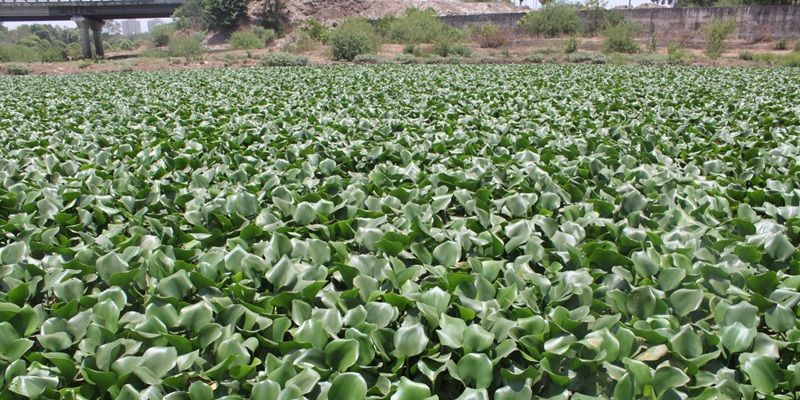In a narrow strip of land between the shores of Lake Albert and the Semuliki Wildlife Reserve sits the Ugandan town of Ntoroko. Although its position sounds idyllic, life there is not easy. Fish stocks in the lake, upon which Ntoroko’s fishing industry depends, are dwindling. Persistent flooding has made many homes inhabitable. Both problems share a root cause: water hyacinth.
The plant was introduced to Africa in the 1980s and has become a serious pest on many of Uganda’s lakes. Water hyacinth (Pontederia crassipes) destroys fish stocks by draining oxygen from the water, clogs irrigation channels and transportation routes, exacerbates flooding and provides a breeding ground for mosquitoes. But an international research project has found a way to use this problem to help solve another: access to clean and affordable energy.

The research looked at the possibility of using water hyacinth as a feedstock for anaerobic digesters, which can produce biogas for use in cooking.
Around 2.4 billion people around the world – including many in Ntoroko district– cook using highly polluting and inefficient fuels such as wood, charcoal, cow dung and coal, often on open fires inside poorly ventilated houses.
Globally each year, 3.2 million people die prematurely due to diseases linked to indoor air pollution. The majority are women and children, as they spend more of their time in the home.
Indoor pollution from cooking fuels is rife across both Uganda and India – and both suffer equally from invasion by water hyacinth – though the energy inequalities differ slightly across each country. In Ntoroko, for example, collecting wood within the wildlife reserve is forbidden, and available stocks outside the reserve are dwindling. In India, while it’s possible to buy bottled gas for cooking, for many, especially in poorer, rural communities, the cost of that is prohibitive.
Assessing the potential of water hyacinth

The researchers, from the University of Leeds, the Centre for Research in Energy and Energy Conservation (CREEC) in Uganda and the Institute of Chemical Technology and Visva Bharati University in India, first looked at the composition of water hyacinth and how that differed across different sites, analysing the effect those differences would have on biogas generation. They looked at options for pre-treatment and additives as well as different digester designs that could improve the efficiency of the process.
With the help of two small energy companies, Defiant Renewables from India, whose CEO is a Leeds alumnus, and Green Heat from Uganda, demonstration digesters were built in both countries, including one in Ntoroko district.
CREEC worked with the local community in Ntoroko to decide where to site the demonstration digester, with cattle farmer Rose Mugume the final choice. Rose has 100 cows and her farm is close to the lake shore, enabling her to feed the digester with sufficient water and the right mix of dung and water hyacinth to provide the gas she needs. Rose’s farm is now being used to show others in the community how the digesters work, to encourage more to be built.
Although the health risks involved with indoor pollution might seem a powerful argument to change to other fuels, the reality is more complicated, as Flavia Ajambo from CREEC explains: “When something as integral to our lives as cooking our food has always been done a certain way, it can be hard for people to change. They may worry that the food will taste differently or have a different texture. So, there are lots of social factors to take into account when you’re asking people to change the way they live.”
Ensuring equitable international collaboration
It’s important that the technologies and processes themselves are developed locally. You can’t just import something that works well in Europe or Asia and expect it to work in the African context.
The BEFWAM (Bioenergy, fertiliser and clean water from invasive aquatic macrophytes) project, is one of many undertaken through the Clean Energy Research Alliance (CERA), a collaboration between researchers in Uganda, Tanzania, Congo-Brazzaville, India, Indonesia and the University of Leeds.
Fundamental work is undertaken at institutions like the University of Leeds, where the facilities allow it, and the outcomes are put into practice by partners in each country, working with local communities, as Dr Mary Suzan Abbo, Managing Director of CREEC, explains:
“Both the UK and India have better facilities than we have in Uganda for biogas testing and we’ve been able to draw on those resources for the research. But it’s important that the technologies and processes themselves are developed locally. You can’t just import something that works well in Europe or Asia and expect it to work in the African context. That’s why the collaboration with CERA and the University of Leeds works so well – we design the projects together to produce solid and sustainable outcomes right from the start.”
Following on from BEFWAM, the University of Leeds is now supporting the creation of an international network to look at all potential uses for invasive aquatic plants, from clothing or baskets made from plant fibres, to animal feed, fertilisers, as well as, of course, energy. Plants like water hyacinth can also be used for environmental benefit, as they have the ability to suck excess nutrients and heavy metals from bodies of water.
Dr Andy Ross, Associate Professor in Energy and Resource Recovery at the University of Leeds said: “We’re working with CREEC and our partners in India to set up a series of seminars across Africa for organisations who are interested in tackling water hyacinth and other invasive aquatic plants. Our aim is to bring all the stakeholders together, to look at ways to transform this environmental problem into a future opportunity.
“BEFWAM definitely proved the potential of using water hyacinth to create biogas,” he added. “But what the project has really demonstrated to me is the enormous opportunity for utilising water hyacinth for a range of different things, all of which can help to tackle inequalities and improve people’s lives, livelihoods and health outcomes.”